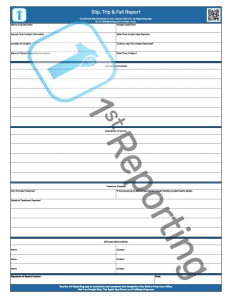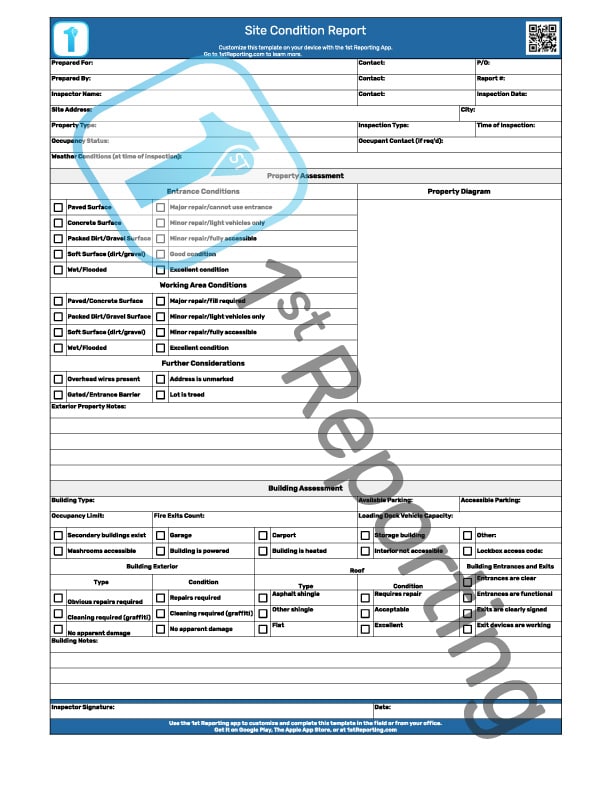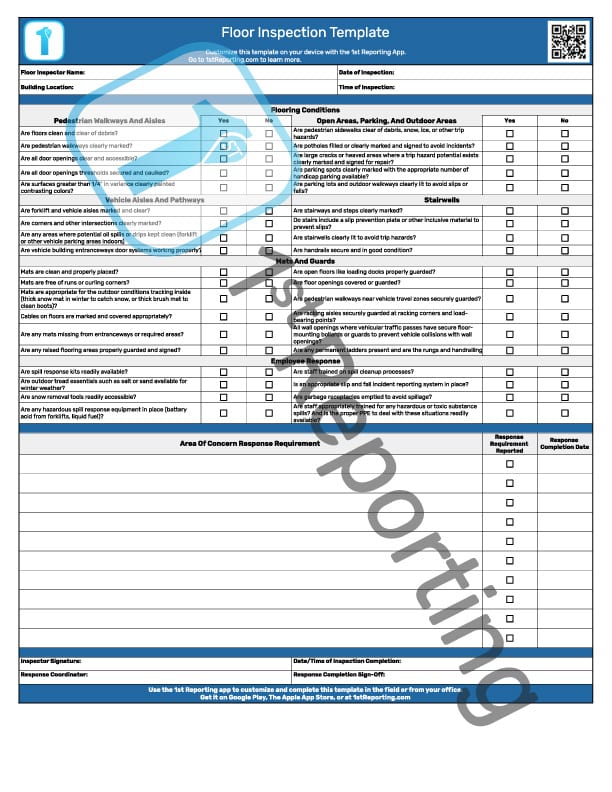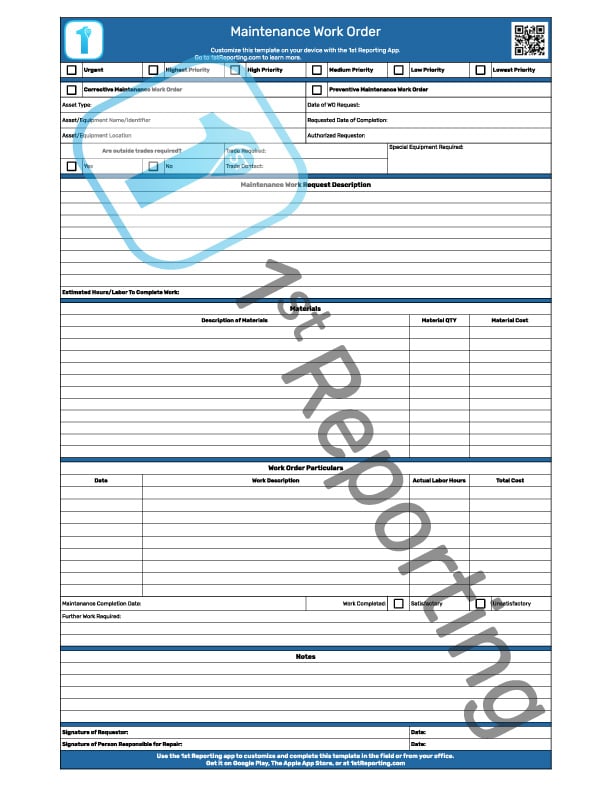Slips or trip and fall reports are a necessary part of incident management. Slips and falls account for the most considerable portion of workplace injuries that result in lost time accidents. Due to the potential severity of such seemingly trivial events, instituting a proper trip and fall report into your organization becomes essential.
Organizations use a slip, trip, and fall report in the workplace to record observations of a slip, trip, and fall incident. As this type of incident is the most common, it becomes clear that a dedicated form for standardized reporting is obviously needed across industries and organizations.
This guide will outline what needs to be on a slip, trip, and fall report, why they are so critical, how to use the report, and further best practices for your team. Furthermore, we have a downloadable PDF or a digital version of our form on the 1st Reporting app for you. Stick with us until the end, and you’ll learn some valuable tips and insights into how you can reduce the risk of these common injuries and create a safer workplace (while simultaneously making your job more manageable). Let’s get started.
Included in the Slip, Trip, and Fall Report Template

You’ll notice that our Slip, Trip, and Fall Report Template includes six conveniently separated regions. I recommend you bookmark this page to reference it later to help you train your team on the report’s intended use. Let’s talk briefly about what we’ve included in the separated regions of our Slip, Trip, and Fall Report Template.
Administrative Data
At the top of the ST&F Report (Slip, Trip, and Fall Report), you’ll notice that there is a convenient section to include data such as the name and contact of the injured party, the location, date, and time of the incident, the date and time of the report creation and when the incident was initially reported. Further details are also included to ensure ease of information sharing. Furthermore, this information is critical to properly sort, file, store, and retrieve your paper reports.
Description of Incident
For obvious reasons, a detailed description of the incident is needed on the form. We’ve provided ample space for your report creator to include the information. Remember to provide this information clearly and concisely, without judgment or malice. The key here is impartiality. You want to record the events as they unfolded and refrain from including personal judgments or assumptions. Remember, the intent here is to document observations objectively and without bias.
Description of Injuries
Following the incident description, which is vital for your Root Cause Analysis, we’ve included an area to document the extent of the injured party’s injuries. Again, it’s critical to reserve judgment and only record observations truthfully and without bias.
Treatment Provided
Treatments as simple as washing a cut and putting on a bandage are still treatments provided. Ensure that in the case of a slip, trip, and fall event, you record and document the event in its entirety. To properly analyze and work toward incident prevention, all information relevant to the scenario must be found in your report. Documenting treatment is also required in terms of liability. Whether it’s one of your team administering emergency first aid or even calling 911, either way, is an action to provide or have a professional provide treatment.
Witness Information
When an accident happens, you must record any witnesses present and privy to the incident. Anyone who saw what happened should have their name and contact information on the slip, trip, and fall report. This contact information may be vital later, so don’t skip noting witness information.
Sign-Off
Finally, the bottom of our slip, trip, and fall report contains a section for your report writer to sign off on the report’s authenticity and provide a completion date. Adding these pieces of information provides two critical things. First, a signature pushes team members to complete their reports honestly and as directed or requested. Secondly, it provides a means of knowing when the report was completed.
How to Use a Trip and Fall Report Form

Using our trip and fall report is straightforward. You only need to download our form and print as many copies as you see fit. Remember that the annual percentage of workers who will face a slip and fall incident is typically around 2.5-3%.
For every 100 team members, you can anticipate 3 of them having a lost time accident due to a fall every calendar year. Remember that these are average numbers based on historical data, and the better you prepare and prevent, the lower your chances of having an at-work incident.
Tips For Managing Slips or Trip and Fall Reporting

Slips, trips, and falls are nothing new in the workplace. No matter the country or industry, we all face daily risks at work. Seton.co.uk says 29% of all workplace accidents reported are slips, trips, or falls. That’s a third of all reported injuries at work in the UK. That’s a significant number, and it’s no different in North American countries.
Luckily, we’ve got a lot of experience reporting injuries. You might say we are experts in workplace reporting and documentation. That said, we’ve compiled a list of the best things you can do to make a difference in your organization.
- Standardize Procedures
- Encourage Hazard Recognition And Jobsite Awareness
- Implement Strict Engineering And Administrative Controls
- Don’t Forsake Training
- Implement Digital Report Solutions
To make the most of these tips, let’s examine each one to determine the best way to implement it into your operations.
Standardize Procedures
I can’t stress enough how essential it is to define procedures for injury incidents. These types of incidents are critical to handle appropriately and not just to come to the aid of the injured party. Given the nature of injuries at work, it’s easy to understand how team members might be too stressed or flustered to deal with an injury incident appropriately.
Due to the importance of handling injuries properly, we’ve created the Injury Procedure Checklist—a tool you and your team can use to ensure that all team members follow the proper steps when dealing with an injury incident at work.
Encourage Hazard Recognition And Jobsite Awareness
I’ve worked at plenty of companies where bad cultural practices discourage safety. You know, the types, those managers who tease or taunt team members over safety concerns. These sorts of occasions call for more level-headed approaches to management.
The best thing you can do, whether a manager or a worker, is to encourage safety, safety awareness, and hazard recognition. Here’s how:
- Thank coworkers for their input.
- Discourage anyone from behaving in a way that makes people feel pessimistic about addressing safety concerns.
- Listen and act: When a team member shares a safety concern, listen to them and act accordingly to help prevent or mitigate threats and hazards.
Implement Strict Engineering And Administrative Controls
Implementing strict engineering and administrative controls to prevent and stop injury incidents is critical to a successful health and safety policy. Ensure that your maintenance team is capable of dealing with safety concerns promptly. Maintaining an intelligent work order document control system will help ensure that safety concerns don’t retain their hazards for longer than necessary.
Don’t Forsake Training
Training is vital to a safe work environment. Management often thinks of training negatively because it is a cost of business without an apparent return on investment. However, the cost of loss of life and limb is always higher than the cost of training.
The biggest mistake I’ve seen in companies over the years is their neglect of refresher safety training. Furthermore, I’ve witnessed far too many lazy managers joke about the lack of importance of safety training. Remember that problems in companies usually start at the top and trickle down. So, if you want a safe work environment, you need to work to maintain it actively.
Implement Digital Report Solutions
Implementing a digital reporting system was one of the smartest moves I have ever made in operations management. I can’t tell you how many times paperwork came back incomplete, messy, or not at all. Digital reporting changes all of that in an instant.
Take the 1st Reporting app, for example. It’s easy to install on any Android or iOS device, works with your desktop or laptop, and even works with the Microsoft Teams® environment. Furthermore, the customizable template builder makes the app reporting custom to your operations (very convenient).
Despite the money saved from not printing paper reports (ink gets expensive, fast), the greatest savings are from the efficient and effective means of reporting and documenting incidents, inspections, audits, and even things like daily shift reports or other reports.
1st Reporting delivers an all-inclusive reporting management experience, from mobile form completion in the field to form customization for your entire organization. It’s my go-to for GPS-accurate reporting solutions. It works on the fly, in the field, and even when out of a cellular signal.
Please don’t take my word for it; take your competitors’ word (they are probably already using 1st). The only question remains: Why haven’t you implemented digital reporting in your organization yet?




